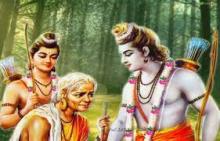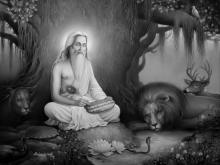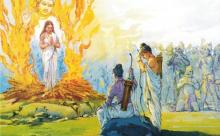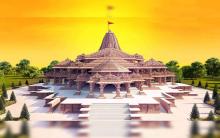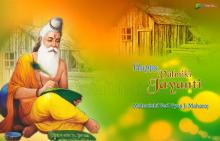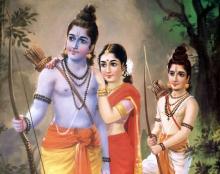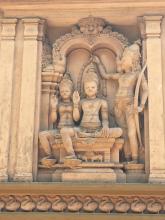Bhāratavarṣa, the geographical expression of the Hindu civilisation, has been undergoing an unprecedented transformation since the last decade. In several realms, the transformation appears to be rapid and it has occurred before our own eyes.
Author:shashikiran
ಶ್ರೀರಾಮನ ಜನ್ಮಸ್ಥಾನವಾದ ಅಯೋಧ್ಯೆಯಲ್ಲಿ ರಾಮಮಂದಿರ ನಿರ್ಮಾಣವಾಗಿರುವುದು ಒಂದು ವಿಶೇಷ ಐತಿಹಾಸಿಕ ಘಟನೆ. ಅದಕ್ಕೆ ಸಂದ ಹೋರಾಟವೇ ಒಂದು ಪರ್ವ. ಬಹುಶಃ ಜಗತ್ತಿನ ಯಾವ ದೇವಾಲಯಕ್ಕೂ ನಡೆಯದ ಐದು ಶತಮಾನಗಳ ಹೋರಾಟ ಅಯೋಧ್ಯಾನಗರದ ರಾಮನ ದೇವಾಲಯಕ್ಕೆ ನಡೆದಿದೆ. ಹದಿನೈದನೆಯ ಶತಮಾನದಿಂದ ಬ್ರಿಟಿಷರ ಆಳ್ವಿಕೆಯ ಆರಂಭದವರೆಗೂ ಮೊಘಲರ ವಿರುದ್ಧ ಸೆಣಸಾಡಿದ್ದಾಗಲಿ, ಬ್ರಿಟಿಷರ ಕಾಲದಲ್ಲಿ ಅವರ ರಾಜಕೀಯ-ನ್ಯಾಯಾಂಗ ವ್ಯವಸ್ಥೆಗೆ ಅನುಗುಣವಾಗಿ ನಮ್ಮ ದೇವಾಲಯಕ್ಕೆ ನಡೆಸಿದ ಹೋರಾಟವಾಗಲಿ, ಬ್ರಿಟಿಷರಿಂದ ಸ್ವಾತಂತ್ರ್ಯ ಪಡೆದೂ ಭಾರತೀಯರು ಸ್ವಧರ್ಮನಿಷ್ಠರಾಗಿ ಬದುಕಲಾಗದಿರುವ ದಶಕಗಳಲ್ಲಿ ನ್ಯಾಯಾಲಯದ ಕಟಕಟೆಯಲ್ಲಿ ನಮ್ಮ ದೇವರನ್ನು ನಿಲ್ಲಿಸಿ ವಾದಿಸಿದ್ದಾಗಲಿ - ಭಾರತದ ಒಂದು ದುರಂತ ಕಥೆಯನ್ನು ಹೇಳುತ್ತದೆ.
Hanūmān told Rāma, “Queen Maithilī, who has been tormented by grief all this while, was overcome with immense joy upon hearing of your victory. She wishes to see her husband along with Lakṣmaṇa.” Rāma, who was addressed thus by Hanūmān appeared to turn gloomy and tearful. Heaving heavy sighs, he spoke to Vibhīṣaṇa staring at the ground. He said, “Have Sītā decked in divine ornaments and celestial unguents, with her hair freshly washed. Hurry!”
ದೇವಾಲಯಗಳು ಭಾರತೀಯ ಸಂಸ್ಕೃತಿಯ ಕೇಂದ್ರಬಿಂದು ಎಂಬುದು ಸಕಲ ಭಾರತೀಯರೂ ಬಲ್ಲ ತಥ್ಯವೇ ಆಗಿದೆ. ಸುಂದರ ದೇವಾಲಯಗಳ ನಿರ್ಮಾಣವು ಆಡಳಿತ ವರ್ಗದ ದಕ್ಷತೆಯ ಹಾಗೂ ರಾಷ್ಟ್ರದ ಆರ್ಥಿಕ ಸಮೃದ್ಧಿಯ ಸಂಕೇತವೂ ಹೌದು. ಪ್ರಾಚೀನ ಕಾಲದಿಂದಲೂ ಭಾರತಾದ್ಯಂತ ನಿರ್ಮಾಣವಾಗಿರುವ ದೇವಾಲಯಗಳು ಇದಕ್ಕೆ ಪುರಾವೆಯಾಗಿ ನಿಂತಿವೆ. ರಾಮಾಯಣದಲ್ಲಿಯೇ ದೇವಾಯತನಗಳ, ಚೈತ್ಯಗಳ ಹಾಗೂ ಅಧಿಷ್ಠಾನಗಳ ಉಲ್ಲೇಖವಿದೆ. ರಾಮನ ಕಾಲದಲ್ಲಿಯೂ ಅಯೋಧ್ಯೆಯಲ್ಲಿ ದೇವಾಲಯಗಳಿದ್ದವು ಎಂದು ಊಹಿಸಲು ರಾಮಾಯಣದಲ್ಲಿ ಆಧಾರಗಳಿವೆ.
ಜಗತ್ತಿನಲ್ಲಿ ನಮ್ಮ ಇರವೆಂಬ ಭವಕ್ಕೆ ಸಂಬಂಧಿಸಿದ್ದು ಭಾವ. ಮಾನವನ ನಿಜವಾದ ಗುರುತು ಭಾವವೇ; ಭಾವ ಉಳ್ಳವನು ಎಂಬುದೇ ಅವನ ಸರಿಯಾದ ಲಕ್ಷಣ. ವೈಯಕ್ತಿಕ ಇಷ್ಟಾನಿಷ್ಟಗಳಿಂದ ರೂಪುಗೊಳ್ಳುವ ಭಾವಗಳು ಸ್ವಾರ್ಥದ ವಿವಿಧ ಮುಖಗಳು, ಅದಕ್ಕಿರುವ ಬಗೆಬಗೆಯ ನೆಲೆಗಳು. ಸ್ವಾರ್ಥದ ಸೆಲೆಯಲ್ಲಿ ಸಿಲುಕಿದ ಜೀವಕ್ಕೆ ಯೋಗಕ್ಷೇಮಗಳೇ ಮುಖ್ಯವಾಗಿ ಮನಸ್ಸಿನ ವಿಶ್ರಾಂತಿ ದೂರವಾಗುತ್ತದೆ. ಚಿತ್ತವಿಶ್ರಾಂತಿ ಇಲ್ಲದ ಬದುಕು ಬರಡಾಗುತ್ತದೆ; ಬೇಗದಲ್ಲಿಯೇ ಬೇಸರ ತರಿಸಿ ಅಸಹ್ಯ ಎನಿಸುತ್ತದೆ. ನಿತ್ಯದ ಬದುಕಿನಲ್ಲಿ ಚಿತ್ತವಿಶ್ರಾಂತಿ ನಮಗೆ ಕಂಡುಬರುವುದು ಗಾಢನಿದ್ರೆಯಲ್ಲಿ. ಆಗ ನಾವು ನಮ್ಮಲ್ಲಿಯೇ ನೆಲೆಗೊಂಡು ಆನಂದವನ್ನು ಅನುಭವಿಸುತ್ತೇವೆ. ಹೀಗೆ ದೊರೆತ ಆನಂದವು ನಿದ್ರೆಯಿಂದ ಎಚ್ಚೆತ್ತ ಕೂಡಲೆ ಕಣ್ಮರೆಯಾಗುತ್ತದೆ.
As the army of the rākṣasas was routed in the war, the wives of the rākṣasas, who were now widowed were grief-stricken. They huddled together and spoke to each other, “How did the ugly-looking, pot-bellied Śūrpaṇakhā even think of making advances towards Rāma? Though he looks soft, he is immensely powerful. He possesses the best of virtues and is handsome; on the contrary, this rākṣasī is hideous and possesses no good quality at all. She is fit to be killed by the world.
इसी शौर्य भाव को हम ऋषि विश्वामित्र में भी देखते हैं जिन्होने राम को क्षात्र दीक्षा प्रदान की थी। एक महर्षि बनने से पूर्व विश्वामित्र ने ब्राह्म के साथ संघर्ष करते हुए ब्राह्म के कठिन पथ के महत्व का अनुभव कर, ब्राह्म क्षात्र समन्वय की महत्ता को समझा। अपने इस अनुभव के उपरांत वे सदैव सत्य के पथ पर चलते हुए अन्ततः आचार्य के पद पर प्रतिष्ठित हुए। परशुराम जो स्वयं एक ब्राह्मण थे, क्षत्रियों से लड़ते हुए क्षात्र में गहराई से सराबोर थे। वे भी अपने इस कृत्य की व्यर्थता को समझ कर आत्मबोध के मार्ग पर अग्रसर हुए। विश्वामित्र को वशिष्ठ ने तथा परशुराम को राम ने यथार्थ का मार
A doubt here. "sarvadharmān parityajya" (having given up all dharmas), "māmekaṃ śaraṇaṃ vraja" (surrender unto Bhagavān alone) - is the instruction. Fine. What is the intent behind - “surrender after having given up all dharmas”? Isn’t surrender a dharma too? Or is surrender an adharma? If the verse had "anya-dharmān" (giving up other dharmas) instead of "sarva-dharmān" (giving up all dharmas), this doubt would not have arisen.
Indrajit quickly understood Rāma’s strategy. The master of illusions placed before him an illusory Sītā and pretended to kill her before his enemies’ eyes. As an enraged Hanūmān rushed at him, he noticed Sītā in Indrajit’s chariot. She looked sorrowful and her face was pale because of fasting; the lady, Rāma’s beloved, wore but a single piece of garment which was unwashed and worn out. Hanūmān observed her for a moment and concluded that she was certainly Maithilī and shed tears.

